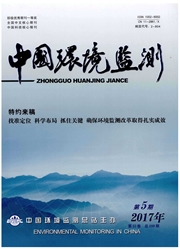

 中文摘要:
中文摘要:
在现场采样数据的基础上,运用Arc GIS的地统计学组件分析了固城湖春季水环境因子空间变异规律,并从污染源分布、水生植物密度差异方面探讨了水环境因子空间变异产生的原因。结果表明:(1)变异函数选择球状模型和高斯模型拟合水环境因子的变差曲线,从预测误差判断,拟合效果很好,因此,固城湖水环境因子的空间分布图比较真实地反映了固城湖水环境现状;(2)固城湖TN、NH4^+-N基本上呈现从南到北逐渐升高的趋势,TN、NH4^+-N、SD的空间变异主要是由人类活动引起,水草对TN、NH4^+-N的吸收作用、SD的改善作用不明显;(3)大湖区TP基本上呈现从中西部向东逐渐升高的趋势,与大湖区水草密度的变化趋势相反;水草密度越大(大湖中南部)pH越高,而水草密度越小(航道、湖东部)pH越小;(4)中南部湖区围网的全部拆除、港口河上游生活污水减少,都使得中南部湖区水质得到改善。
 英文摘要:
英文摘要:
Based on the investigation data, the theory and method of geostatistics were used to characterize the spatial distribution of water quality factors of Gucheng Lake, and analyzed its causes from pollution source distribution, hydrophyte density variation. The results showed : ( 1 ) To choose Spherical mode and Gaussian mode of Semivariance fitted variation curve of water quality factors and had fitting effects according to prediction errors. So the figure of spatial distribution of water quality factors reflected water environmental status quo indeed; (2) The content of TN,NH4^+ -N increased gradually from south to north,and spatial variability of TN,NH4^+ -N.SD was mainly caused by human activity; absorbing of TN,NH4^+ -N and improving of SD by hydrophytes were not remarkable; (3) The content of TP increased gradually from mid-west to east, in contrast to hydrophyte density variation; The value of pH increased with hydrophyte density increase; (4) Removal of purse seine in the mid-south lake and decrease of domestic sewage in Gangkou River made water quality improve in this area.
 同期刊论文项目
同期刊论文项目
 同项目期刊论文
同项目期刊论文
 期刊信息
期刊信息
